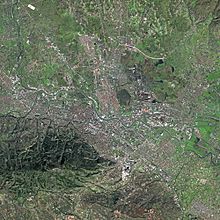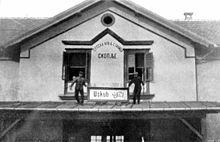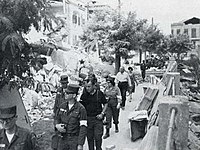Skopje (Macedonian: Скопје, [ˈskɔpjɛ] ( )) is the capital and largest city of the Republic of Macedonia. It is the country's political, cultural, economic, and academic center. It was known in the Roman period under the name Scupi.
)) is the capital and largest city of the Republic of Macedonia. It is the country's political, cultural, economic, and academic center. It was known in the Roman period under the name Scupi.
The territory of Skopje has been inhabited since at least 4000 BC; remains of Neolithic settlements have been found within the old Kale Fortress that overlooks the modern city centre. On the eve of the 1st century AD, the settlement was seized by the Romans and became a military camp.[2][3] When the Roman Empire was divided into eastern and western halves in 395 AD, Scupi came under Byzantine rule from Constantinople. During much of the early medieval period, the town was contested between the Byzantines and the Bulgarian Empire, whose capital it was between 972 and 992. From 1282, the town was part of the Serbian Empire and acted as its capital city from 1346. In 1392, the city was conquered by the Ottoman Turks who renamed the town Üsküp. The town stayed under Ottoman control over 500 years, serving as the capital of pashasanjak of Üsküb and later the Vilayet of Kosovo. At that time the city was famous for its oriental architecture[citation needed]. In 1912, it was annexed by the Kingdom of Serbia during the Balkan Wars[4] and after the First World War the city became part of the newly formed Kingdom of Serbs, Croats and Slovenes (Kingdom of Yugoslavia). In the Second World War the city was conquered by the Bulgarian Army, which was part of Axis powers. In 1944, it became the capital city of Democratic Macedonia (later Socialist Republic of Macedonia), which was a federal state, part of Democratic Federal Yugoslavia (later Socialist Federal Republic of Yugoslavia). The city developed rapidly after World War II, but this trend was interrupted in 1963 when it was hit by a disastrous earthquake. In 1991, it became the capital city of an independent Macedonia.
Skopje is located on the upper course of the Vardar River, and is located on a major north-south Balkan route between Belgrade and Athens. It is a center for metal-processing, chemical, timber, textile, leather, and printing industries. Industrial development of the city has been accompanied by development of the trade, logistics, and banking sectors, as well as an emphasis on the fields of culture and sport. According to the last official count from 2002, Skopje has a population of 506,926 inhabitants; according to two unofficial estimates for more recent period, the city has a population of 668,518[5] or 491,000 inhabitants.[6]
Contents
[show]Etymology[edit]
See also: other names of Skopje
The name of Skopje is derived from an ancient name that is attested in antiquity as Latin Scupi, the name of a classical era Greco-Roman frontier fortress town[7] of Thracian (Paeonian) origin.[8][9] In modern times, the city has been known by its Ottoman Turkish name Üsküp(Ottoman Turkish: اسكوب) during the time of Ottoman rule and by the Serbian form Skoplje (Скопље) during the time of the Royal Yugoslavia between 1912 and 1941. Under the Kingdom of Bulgaria (1941–1944), the city was called Skopie (Скопие). Since 1945, the official name of the city in Macedonian has been Skopje (Скопје), reflecting the Macedonian Cyrillic orthography for the local pronunciation.
Geography[edit]
Skopje is located in the Skopje statistical region of northern Macedonia, in the centre of the Balkans, approximately halfway between Belgrade and Athens. The Vardar River, which originates near Gostivar, flows through the city then flows south passing the border into Greece and eventually flowing into the Aegean Sea. The Vardar valley consists primarily of hills and mountains. The city covers an average length of 23 kilometres (14 miles) from east to west and 9 km (6 mi) from north to south. Skopje is located at an elevation of 225 m (738 ft) above sea level. The city's land area is 1,854 km2 (716 sq mi).
Climate[edit]
The climate of Skopje is usually classified as continental sub-Mediterranean,[10][11] while according to the Köppen climate classification it has a humid subtropical climate (Cfa), with a mean annual temperature of 13.5 °C (56 °F).[12] Precipitation is relatively low due to the pronounced rain shadow of the Prokletije mountains to the northwest, being only a quarter of what is received on the Adriatic Sea coast at the same latitude. The summers are long, hot and humid, while the winters are short, relatively cold, and wet. Snowfalls are common in the winter period, but heavy snow accumulation is rare and the snowcover lasts only for a few days. In summer, temperatures are usually above 31 °C (88 °F) and sometimes above 40 °C (104 °F). In spring and autumn, the temperatures range from 15 to 24 °C (59 to 75 °F). In winter, the day temperatures are roughly 6 °C (43 °F), but at nights they often fall below 0 °C (32 °F) and sometimes below −10 °C (14 °F). Occurrences of precipitation are evenly distributed throughout the year, being heaviest from October to December and from April to June.
| [show]Climate data for Skopje |
|---|
Hydrography[edit]
In Skopje, the Vardar River is 60 miles (97 km) from its source near Gostivar. The river makes a few large meanders in Skopje and is crossed by several bridges, five in the center of the city.
Several rivers flow into the Vardar in Skopje. The longest is the Treska, which is 130 km (81 mi) long. Others include the Lepenec, Pčinja, Kadina Reka, Markova Reka and Pateška, which are all less than 70 km (43 mi) long.[16]
Skopje's two artificial lakes, Matka and Treska, are supplied by the Treska River, located just few kilometers outside the city center. The city also has a glacial lake called Jakupica.[16]
Geology[edit]
Seismic movements have formed medium-sized mountains around the city. The city of Skopje is bordered by Šar Mountains to the west, by the Jakupica chain to the south, and by hills to the east that form the early Osogovo Mountains, which are situated on the border between Macedonia and Bulgaria.[16]
The highest point in the center of Skopje is at an altitude of 1066 meters which is far exceeded by the mountains Osoj, Skopska Crna Gora, and Žeden which have heights of 1506 meters, 1260 meters and 1561 meters respectively.[16]
Some rivers, like the Matka, have created ravines around the city. The canyon of the Treska River is surrounded by caves.[16]
Town planning[edit]
Skopje has a rather loose town planning, which is the result of an earthquake that destroyed 80% of the city in 1963.[17][18]
The center of Skopje consists of two municipalities separated by the Vardar River. On the north bank of the river is Čair Municipality, in which the Old Town is located, while the on the south bank is Centar Municipality, which is the modern part of the center of the city.
Rebuilding after the earthquake was largely orchestrated by Kenzo Tange,[19] a Japanese architect and urban planner who had drawn many plans for cities and towns including that for Hiroshima in 1949. The most significant accomplishment was the train station, which was built on an elevated platform over bridges and allows for the separation of traffic and pedestrians. The planning of the southern bank of the Vardar has been designed to accommodate 1,800 homes lost in the earthquake.[19]
The combination of the earthquake, Yugoslav social planning, and UN funded plans created an environment in Skopje for some unusual building projects from the mid-1960s onwards. A notable example is the central post office, a circular building which was designed by architect Janko Konstantinov.[20]
Skopje 2014 project[edit]
Main article: Skopje 2014
The city is spreading in all directions and is experiencing a number of new developments.[21] In 2010, the government launched the "Skopje 2014" project which aims to give a more monumental appearance to the capital.[22][23] It made plans to erect a lot of statues, fountains, bridges, and museums at a cost of about €500 million.[24] The project has generated controversy: critics have described the new landmark buildings as signs of a reactionary historicistaesthetics.[25] However, the government has been criticised for its cost and for the lack of representation of national minorities in the coverage of its set of statues and memorials.[25] It is accused for turning Skopje to a theme park,[26]which is viewed as nationalistic kitsch,[27] and has made Skopje an example to see how national identities are constructed and how this construction is mirrored in the urban space.[28]
History[edit]
Main article: History of Skopje
See also: Timeline of Skopje history
The site of modern Skopje has been inhabited since at least 4000 BC.[16] Remains of Neolithic settlements have been found within the Skopje Fortress. The earliest identifiable people in the Skopje Valley were probably the Triballi.[29] Later the area was populated by the Paionians, but in the 3rd century BC, Skopje and the surrounding area was invaded by the Dardanians. Scupi, the ancient name for Skopje, became the capital of Dardania, which extended from Naissus to Bylazora in the second century BC.[30] Roman expansion east brought Scupi under Roman rule as a colony of legionnaires, mainly veterans of the Legio IIV Claudia in the time of Domitian (81-96 AD). However, several legions from the Roman province of Macedonia of Crassus' army may already have been stationed in there around 29-28 BC, before the official imperial command was instituted.[31][32] Shortly afterwards it became part of the province of Moesia during Augustus's rule.[33] After the division of the province byDomitian in 86 AD, Scupi was elevated to colonial status, and became a seat of government within the new province of Moesia Superior. The district called Dardania (within Moesia Superior) was formed into a special province by Diocletian, with the capital at Naissus. From 395 AD, it passed into the hands of the Byzantine Empire. Scupi was probably a metropolitan seat during the middle of the 5th century.(Latin: Archidioecesis Scopiensis).[34]
After becoming part of the Byzantine Empire, Scupi became an important regional trading centre and garrison. Byzantine Emperor Justinian (527–65 AD) was born in Tauresium,[35] a town roughly 20 km (12 mi) southeast of present-day Skopje, in 483 AD. After Scupi was almost completely destroyed by an earthquake in 518 AD, Justinian, according to his historian Procopius in "De Aedificiis" (On the Buildings), built a new city near his birthplace Tauresium and Bederiana[36] (believed to be today's villages Taor and Bader) at the fertile entry point of the River Lepenec into the Vardar, making Skopje the city of Justiniana Prima.[37][38] During much of the early medieval period, the town was contested by both the Byzantines and the Bulgarian Empire. From 972 to 992, it was the capital of the First Bulgarian Empire.[39] After 1018, it was the capital of the Byzantine administrative region theme of Bulgaria, after the fall the First Bulgarian Empire in 1018. Skopje was a thriving trading settlement but fell into decline after being hit by another earthquake at the end of the 11th century. In 1189, the town was briefly occupied by the Serbs.[40]
Skopje was the capital of the estate of the Bulgarian feudal lord, later Emperor Konstantin Asen in the middle of 13th century. The Byzantine Empire took advantage of the decline in Skopje to regain influence in the area but lost control of it once again in 1282 to King Stefan Uroš II Milutin of Serbia. Milutin's grandson, Stefan Dušan, made Skopje his capital. He later in 1346 was proclaimed Emperor of Serbs and Greeks,[16] subsequently making Skopje capital of the Serbian Empire. After his sudden death in 1355, he was succeeded by Stephen Uroš V of Serbia who could not keep the Serbian Empire together and it was fragmented in many small principalities.Vuk Branković was the last Serbian and Christian prince to rule Skopje during the medieval period.
After conquering some parts of the Balkans, the Ottoman Turks conquered Skopje in 1392 beginning 520 years of Ottoman rule.[41][42] The Ottomans named the town Üsküb. At first, they established aSanjak of Skopje with Skopje (Üsküb) as its seat. Üsküb was strategically important for further expansion into central Europe.
Under Ottoman rule, the town expanded further towards the confluence point of the Serava and Vardar rivers. The city soon had a large Muslim population and the architecture of the town changed accordingly. During the 15th century, many travelers' inns, such as Kapan An and Suli An, were established in the town. The city's famous Stone Bridge was reconstructed during this period and the Daut Pasha baths were built at the end of the 15th century. Also at this time, numerous Sephardic Jews driven out of Spain in 1492 settled in Üsküb, adding to the cultural mix of the town and enhancing the town's trading reputation.[16]
At the beginning of Ottoman rule, several mosques sprang up in the city, and church lands were often seized and given to ex-soldiers, while many churches themselves were converted over time into mosques.[43] Üsküb was briefly occupied in 1689 by the Austrian General Enea Silvio Piccolomini. He and his troops did not stay for long, however, as the town was quickly engulfed by the plague, which ultimately killed Piccolomini in December 1689. On retreating from the town Piccolomini's troops set fire to Üsküb, perhaps in order to stamp out the plague, although some say this was done in order to avenge the 1683 Ottoman siege of Vienna.[16] For the next two centuries Üsküb's prestige waned and by the 19th century its population had dwindled to a mere 10,000. In 1873, however, the completion of the Üsküb—Selanik (now Skopje—Thessaloniki) railway brought many more travelers and traders to the town, so that by the start of the 20th century Üsküb had regained its former numbers of around 30,000.[16]
By the 17th century, the city of Skopje had a diverse religious population which included Orthodox Christians, Muslims, Roman Catholics and Jews. The Roman Catholic Diocese of Skopje had religious leaders from diverse backgrounds, including Bosnian, Italian, Bulgarian, Macedonian and Greek friars such as Giacinto Macripodari (c. 1610–1672) who administrated from Skopje in the 17th century.[44][45]
At that time, Skopje was the capital of Kosovo vilayet as an Ottoman vilayet. During the Ottoman Tanzimat (1839–76) reforms, nationalism arose in the Empire and in 1870 a new Bulgarian Orthodox Church was established and its separate diocese was created, based on ethnic identity rather than religious principles.[46] The Christian population of the bishopric of Skopje voted in 1874 overwhelmingly, by 91% in favour of joining the Exarchate.[47]
In 1893, the Internal Macedonian Revolutionary Organization was established in Thessaloniki by a small band of anti-Ottoman Macedono-Bulgarian revolutionaries, who considered Macedonia an indivisible territory and claimed all of its inhabitants "Macedonians", independently of their religion or ethnicity.[48] In 1903, an organized revolt against the Ottoman Empire was carried out by the IMRO. Its revolutionary network in Skopje region was not well-developed and the lack of weapons was a serious problem. At the outbreak of the uprising the rebel forces derailed a military train.[49] On 3 and 5 August respectively, they attacked a Turkish unit guarding the bridge on the Vardar river and gave a battle in the "St. Jovan" monastery. In the next few days the band was pursued by numerous Bashibozuks and moved to Bulgaria.
The Ottomans were ultimately expelled from the city on 12 August 1912 when 15,000 Albanians marched on Üsküb.[50][51]
The Ottoman army could not stand against the united front of Montenegro, Greece, Serbia and Bulgaria during the First Balkan War. When reinforcements to the Serbian royal army arrived some weeks later during the Battle of Kumanovo (50 km (31 mi) northeast of Skopje), it proved decisive in firmly driving out the Ottomans from all of Macedonia.[41][52] In 1912, the Kingdom of Serbia occupied Skopje and the official name of the city was changed from the Turkish name Üsküb to the Serbian name Skoplje (Скопље). The Treaty of London of 1913 legitimated Serbian authority in northern Macedonia.[53] Skopje remained under rule of the Kingdom of Serbia[53] during the Second Balkan War of 1913 when the formerly united front started to fight among themselves. After the outbreak of World War I in 1915, the town was occupied by the Kingdom of Bulgaria. By 1918 it became part of the newly formed Kingdom of Serbs, Croats, and Slovenesand remained so until 1941, apart from six months in 1920 when Skopje was controlled by the Yugoslav Communist Party. A mostly foreign ethnic Serb elite dominated over the rest, imposing a repression, unknown under previous Ottoman rulers.[54] The policies of de-Bulgarisation and assimilation were pursued.[55] At that time part of the young locals, repressed by the Serbs, tried to find a separate way of ethnic Macedonian development.[56] In 1931, in a move to formally decentralize the country, Skopje was named the capital of the Vardar Banovina of the Kingdom of Yugoslavia.
In March 1941 when Yugoslavia entered the war, there were huge anti-war demonstrations in the streets of the town.[57] Skopje came under German occupation on 7 April 1941[58] and was later occupied by Bulgarian forces.[59] As part of a broader 'Bulgarisation' campaign, the occupying forces established a national theatre, a library, a museum and for higher education — the King Boris University.[60]
On 11 March 1943, Skopje's entire Jewish population of 3,286 was transferred by Bulgarian occupying forces to the Nazis and deported to the gas chambers of Treblinka concentration camp in German-occupied Poland.[61][62] This was in stark contrast to the way Bulgaria handled its own Jewish population.[63]
Skopje was liberated on 13 November 1944 by Yugoslav Partisan units of the Macedonian National Liberation Army, together with units of the newly allied Bulgarian People's Army (Bulgaria having switched sides in the war in September).[64][65][66][67] Soon after, Skopje became the capital of the newly established People's Republic of Macedonia within Yugoslavia.
Until 1991, Skopje was the capital of the Socialist Republic of Macedonia.[68] The city expanded and the population grew during this period from just over 150,000 in 1945 to almost 600,000 in the early 1990s.
Continuing to be prone to natural disasters, the city was flooded by the Vardar River in 1962 and then suffered considerable damage from a major earthquake[69][70] measuring 6.1 on the Richter scale, which killed over 1,000 people[69][71] and made another 120,000 homeless.[17][71] Numerous cultural monuments were seriously damaged. A major international relief effort saw the city rebuilt quickly, though much of its old neo-classical charm was lost in the process. The new master plan of the city was created by the leading Japanese architect Kenzo Tange. The ruins of the old Skopje train station which was destroyed in the earthquake remain today as a memorial to the victims with an adjacent museum. Nearly all of the city's beautiful neo-classical 18th and 19th century buildings were destroyed in the earthquake, including the National Theater and many government buildings, as well as most of the Kale Fortress. International financial aid poured into Skopje to help rebuild the city. As a result came the many modern (at the time) brutalist structures of the 1960s, that can still be seen today, such as the central post office building and theNational Bank, as well as hundreds of now abandoned caravans and prefabricated mobile homes. Fortunately, though, as with previous earthquakes, much of the old Turkish side of town survived.
Skopje made the transition easily from the capital of the Socialist Federal Yugoslav Republic of Macedonia to the capital of today's Republic of Macedonia. Today, Skopje is seeing a makeover in buildings, streets and shops. The new government elected in July 2006 restored the Kale fortress and plans to rebuild the 19th century Army House, the Old National Theatre, and the Old National Bank of Macedonia — all destroyed in the 1963 earthquake. Other projects under construction are the "Macedonian Struggle" Museum, the Archeological Museum of Macedonia, National Archive of Macedonia, Constitutional Court, and a new Philharmonic Theater. The reconstruction of these buildings and also building monuments to the some most famous historic peoples of Macedonia are part of the project Skopje 2014, which should be completely over in the year of 2015. Also, the city's national stadium Philip II Arena [72][73] and the Alexander the Great Airport are being reconstructed and expanded.[74][75]









No comments:
Post a Comment